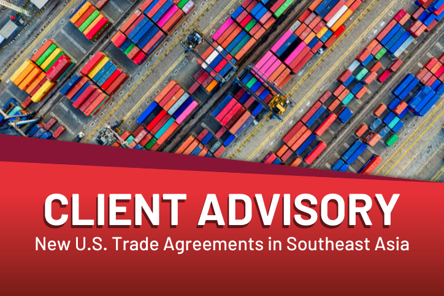WHAT’S THE LATEST
On October 26, President Trump announced new trade agreements with Malaysia and Cambodia, along with framework deals with Thailand and Vietnam. While there are no immediate changes to U.S. tariff rates, these developments highlight evolving trade dynamics in Southeast Asia that could influence shipping, sourcing, and logistics strategies for U.S. exporters and importers.
The details of each agreement and framework are outlined below.
WHAT WE KNOW
Malaysia - Trade Agreement
- Tariffs:
- The U.S. will maintain a 19% reciprocal tariff rate.
- Products listed in Annex III of Executive Order 14346 will receive a 0% reciprocal tariff rate.
- The U.S. will maintain a 19% reciprocal tariff rate.
- Market Access:
- Malaysia will provide preferential market access for U.S. industrial goods exports (chemicals, machinery and electrical equipment, metals, and passenger vehicles) and agricultural exports (dairy, horticultural products, poultry, processed products, beverages, pork, rice, and fuel ethanol).
- Non-Tariff Barriers:
- Malaysia will address the following non-tariff barriers:
- Accept U.S. manufactured vehicles built to U.S. motor vehicle safety and emissions standards.
- Streamline import licenses for U.S. alloy steel and pipe products and steel-containing goods.
- Simplify halal requirements for products including cosmetics, pharmaceuticals, and medical devices.
- Address U.S. concerns regarding conformity assessment procedures.
- Malaysia will address the following non-tariff barriers:
- Digital Trade:
- Malaysia will:
- Refrain from imposing discriminatory digital services taxes.
- Allow cross-border data transfers.
- Support a permanent World Trade Organization (WTO) moratorium on customs duties for electronic transmissions.
- Malaysia will:
- Minerals:
- Malaysia will refrain from export bans on critical minerals and partner with U.S. companies to expand rare earth production.
- Forced Labor Commitment:
- Malaysia has committed to implementing an import ban on goods produced with forced labor, in line with Section 307 of the U.S. Tariff Act of 1930.
- Malaysia has up to two years to establish the ban.
- Further details on enforcement mechanisms and coordination with U.S. Customs and Border Protection (CBP) are forthcoming.
- Next Steps: Negotiations will continue in the coming weeks to finalize and implement the trade agreement.
Cambodia - Trade Agreement
- Tariffs:
- The U.S. will maintain a 19% reciprocal tariff rate.
- Products listed in Annex III of Executive Order 14346 will receive a 0% reciprocal tariff rate.
- Cambodia will eliminate tariffs on all U.S. industrial and agricultural goods.
- The U.S. will maintain a 19% reciprocal tariff rate.
- Non-Tariff Barriers:
- Cambodia will address the following non-tariff barriers:
- Recognize U.S. motor vehicle safety and emissions standards.
- Streamline import licenses for steel, alloy, and pipe products.
- Simplify halal and facility registration for U.S. food, cosmetics, and medical products.
- Accept U.S. sanitary certificates for agricultural goods.
- Address regulatory barriers to U.S. agricultural products, including recognition of U.S. oversight and certification processes.
- Cambodia will address the following non-tariff barriers:
- Digital Trade:
- Cambodia will:
- Strengthen cooperation on intellectual property, trade facilitation, services, and investment.
- Enhance transparency and regulatory alignment to support trade growth.
- Cambodia will:
- Forced Labor Commitment:
- Cambodia has committed to implementing an import ban on goods produced with forced labor, in line with Section 307 of the U.S. Tariff Act of 1930.
- No specific timeline for implementation has been provided.
- Enforcement details and collaboration with the CBP are still to be determined.
- Next Steps: Negotiations will continue in the coming weeks to finalize and implement the trade agreement.
Thailand - Framework Agreement
- Tariffs:
- According to the corresponding fact sheet, the U.S. will maintain a 19% reciprocal tariff rate until a final deal is reached.
- Once finalized, products listed in Annex III of Executive Order 14346 will receive a 0% reciprocal tariff rate.
- Thailand will eliminate tariffs on 99% of U.S. industrial, food, and agricultural products.
- Non-Tariff Barriers:
- Thailand will refrain from imposing new import restrictions on U.S. exports.
- Next Steps: Negotiations will continue in the coming weeks to finalize and implement the trade agreement.
Vietnam - Framework Agreement
- Tariffs:
- According to the corresponding fact sheet, the U.S. will maintain a 20% reciprocal tariff rate until a final deal is reached.
- Once finalized, products listed in Annex III of Executive Order 14346 will receive a 0% reciprocal tariff rate.
- Vietnam will eliminate tariffs on nearly all U.S. goods, including food and agricultural products.
- According to the corresponding fact sheet, the U.S. will maintain a 20% reciprocal tariff rate until a final deal is reached.
- Next Steps: Negotiations will continue in the coming weeks to finalize and implement the trade agreement.
WHAT'S NEXT?
SEKO is actively monitoring these developments to provide clients with the latest information. We will communicate updates as the Thailand and Vietnam agreements are finalized.
We recommend that importers monitor changes to the tariff schedule as Annex III is reviewed to determine whether their products are impacted. We will provide updates to this as they come.
If you have questions, please reach out to your SEKO representative, or email us at hello@sekologistics.com.



